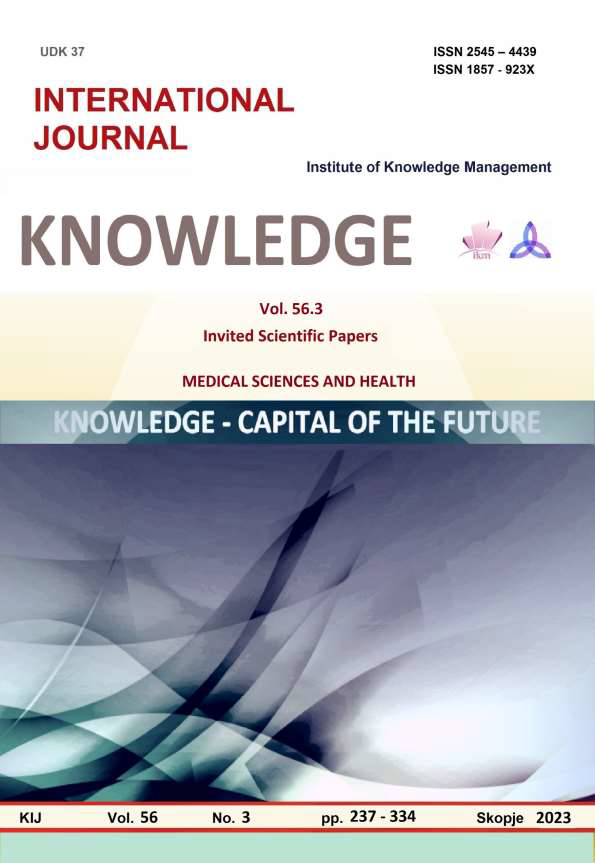ALTERATION OF COAGULATION AND FIBRINOLYSIS IN MALIGNANCY
Keywords:
hemostasis, fibrinolysis, cancerAbstract
Malignant diseases occupy a large part in human pathology. According to the World Health Organization,
they are the second leading cause of death in developed countries, giving way only to cardiovascular diseases. In
2020, more than 10 million people worldwide died from malignant diseases. In men, carcinoma of the lung, prostate,
stomach, rectum and colon are most common. In women, breast cancer is the most common, followed by carcinoma
of the skin and cervix. A common complication in cancer patients is thrombosis. Despite the fact that venous
thromboembolism is a major problem in patients with tumor diseases, studies of the prothrombotic state in these
patients have been neglected. More than 130 years ago, the relationship between carcinogenesis and blood
coagulation disorders was established. Abnormalities in coagulation status are found in up to 50% of all patients
with malignant diseases and up to 90% of those with metastases. Thrombosis is the second most common cause of
death in these patients. Clinical symptoms of coagulation disorders are very often the first sign of malignancy.
Tumor growth, procoagulant properties of tumor and inflammatory cells, neoangiogenesis, vascular-endothelial
dysfunction are some of the causes for thrombogenesis in patients with malignant diseases. The impaired function of
the affected organ, decreased coagulation inhibitors, disturbed balance between the systems of coagulation and
fibrinolysis also play important role in the pathogenetic mechanism of thrombosis. The application of
chemotherapeutic drugs can also lead to disorders in hemocoagulation. Thus, coagulopathy and angiogenesis in the
presence of malignancy actually appear to be anatomically and functionally related. They predispose cancer patients
to an increased risk of thrombotic events or bleeding complications. Changes in laboratory parameters that indicate
activation of coagulation and fibrinolysis such as fibrinogen, thrombin-antithrombin complex (TAT), tissue factor
(TF), prothrombin fragment (F1+2), Antithrombin III (AT III), D-dimer and tissue plasminogen activator (t-PA)
have been of increasing interest over the last decade in this pathology. The study of indicators of coagulation
activation and fibrinolysis together with routine hemostasis tests in patients with malignant pathology would allow
finding a marker or a complex of markers that best reflects changes in the hemostasis system and the risk of
thrombotic events. This might be helpful not only to assess the thrombogenic risk, but also for diagnose, treatment
and prevention of thrombotic complications such as deep venous thrombosis or pulmonary embolism. Cancer
patients are at increased risk of thrombosis and furthers studies need to be performed in order to assess the need of
antithrombotic prophylaxis.
References
Bluff , J.E., et al. (2008). Tissue factor, angiogenesis and tumour progression. Breast Cancer Res, 10(2):204.
Borgfeldt, C., et al. (2003). High preoperative plasma concentration of tissue plasminogen activator (tPA) is an independent marker for shorter overall survival in patients with ovarian cancer, Gynecologic Oncology, 91(1):112-117.
Diao, D., et al. (2017). D-dimer is an essential accompaniment of circulating tumor cells in gastric cancer. BMC Cancer. 17:56.
Giaccherini, C., et al. (2020). Thrombotic biomarkers for risk prediction of malignant disease recurrence in patients with early stage breast cancer. Haematologica. 105(6):1704-1711.
Grebenchtchikov, N., et al. (2005). Measurement of plasminogen activator system components in plasma and tumor tissue extracts obtained from patients with breast cancer: an EORTC Receptor and Biomarker Group collaboration. Oncol Rep. 14(1):235-9.
Gronostaj, K., et al. (2016). Determinants of hypofibrinolysis in patients with digestive tract cancer. Prz Gastroenterol. 11(2):104-10.
Hong, S.K., et al. (2010). Alteration of Antithrombin III and D-dimer Levels in Clinically Localized Prostate Cancer. Korean J Urol.; 51(1):25-29.
Jiang, X., et al. (2017). D-dimer level is related to the prognosis of patients with small cell lung cancer. Ann Transl Med. 5(20):394.
Lundbech, M., et al. (2020). Thrombin generation, thrombin-antithrombin complex, and prothrombin fragment F1+2 as biomarkers for hypercoagulability in cancer patients. Thrombosis Res.186:80-85.
Mego, M., et al. (2015). Circulating tumour cells are linked to plasma D-dimer levels in patients with metastatic breast cancer. Thromb Haemost. 113(2):593–598.
Mitsui, S., et al. (2022). Prognostic value of preoperative plasma fibrinogen levels in resected stage I non-small cell lung cancer. Thorac Cancer.13(10):1490-1495.
Moik, F., et al. (2020). Haemostatic biomarkers for prognosis and prediction of therapy response in patients with metastatic colorectal cancer. Thromb Res. 187:9-17
Reitter, E., et al. (2016). Longitudinal analysis of hemostasis biomarkers in cancer patients during antitumor treatment. J Thromb Haemost.14(2):294-305.
Siddiqui, N.A., et al. (2021). D-Dimer: A Potential Solution to Problems of Cancer Screening, Surveillance, and Prognosis Assessment. Cureus.13(5)
Sierko, E., et al. (2006). Expression of blood coagulation inhibitors in colon cancer. [in Polish] Pol Merkur Lekarski; 20(118):462–467.
Sun, W., et al. (2015). Clinical and Prognostic Significance of Coagulation Assays in Pancreatic Cancer Patients With Absence of Venous Thromboembolism. Am J Clin Oncol. 38(6):550-6.
Tala, J.A., et al. (2020). Protein biomarkers for incident deep venous thrombosis in critically ill adolescents: An exploratory study. Pediatr. Blood Cancer. 67(4):e28159.
Tian, Y., et al. (2017). Clinical and Prognostic Effect of Plasma Fibrinogen in Renal Cell Carcinoma: A Meta-Analysis. Biomed Res Int:9591506.
Trousseau, A., (1872). “Phlegmasia alba dolens” Clinique Medicale de l'Hotel Dieu de Paris, vol. 3, pp. 654–712, 1865, translated by the New Sydenham Society, London as “Lectures on Clinical Medicine delivered at the Hotel Dieu de Paris”, pp. 281–95
Unsal, E., et al. (2004). Prognostic significance of hemostatic parameters in patients with lung cancer. Respir Med; 98:93–98.
Wada, H., Sase, T., & Yamaguchi, M. (2005). Hypercoagulant states in malignant Lymphoma, Exp.Oncol. 27(3):179-185.
Wang, S., Li, Z., & Xu, R. (2018). Human Cancer and Platelet Interaction, a Potential Therapeutic Target. Int. J. Mol. Sci, 19:1246.
Wen, J., et al. (2015). The preoperative plasma fibrinogen level is an independent prognostic factor for overall survival of breast cancer patients who underwent surgical treatment. Breast. 24(6):745-50.
Xia, Q., et al. (2020). Down-regulation of tissue factor inhibits invasion and metastasis of non-small cell lung cancer. J Cancer ; 11(5):1195-1202.





